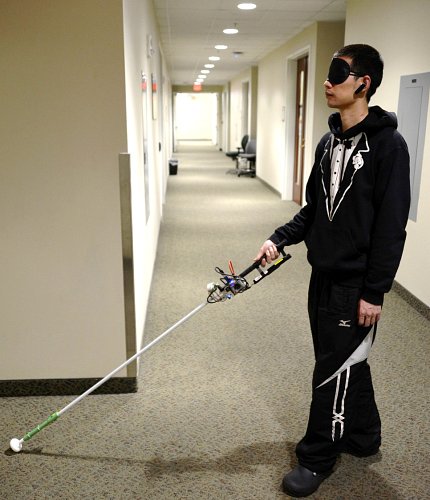New Robotic Cane Offers New Direction

Photo: Cang Ye, VCU
Equipped with a color 3-D camera, an inertial measurement sensor and its own onboard computer, a newly improved robotic cane could offer blind and visually impaired users a new way to navigate indoors. When paired with a building’s architectural drawing, the device can accurately guide a user to a desired location with sensory and auditory cues, while simultaneously helping the user avoid obstacles like boxes, furniture and overhangs.
NEI and NIBIB co-funded the cane’s development. Design details were published in IEEE/CAA Journal of Automatica Sinica.
While there are cell phone-based applications to help blind users stay within crosswalks, for example, large spaces inside buildings are a major challenge. Earlier versions of this robotic cane began tackling the problem by incorporating building floorplans. Users could tell the cane where they wished to go, and the cane—through auditory cues and a robotic rolling tip—could guide users to their destination. But when used over long distances, the inaccuracies could build up, eventually leaving the user at an incorrect location.
To help correct this issue, the cane’s developers added a color depth camera to the system. Using infrared light, the system can determine the distance between the cane and other physical objects, including the floor, doorways and walls, as well as furniture and other obstacles. Employing this information, along with data from an inertial sensor, the cane’s onboard computer can map the user’s precise location to the existing architectural drawing or floorplan, while also alerting the user to obstacles in their path.
There are still a few kinks to be worked out before the system will be market-ready—it’s still too heavy for regular use, for example. Nevertheless, with the ability to switch easily between its automated mode and a simpler, non-robotic “white cane mode,” this device could provide a key independence tool for the blind and visually impaired, without losing the characteristics of the white cane that have stood the test of time.
